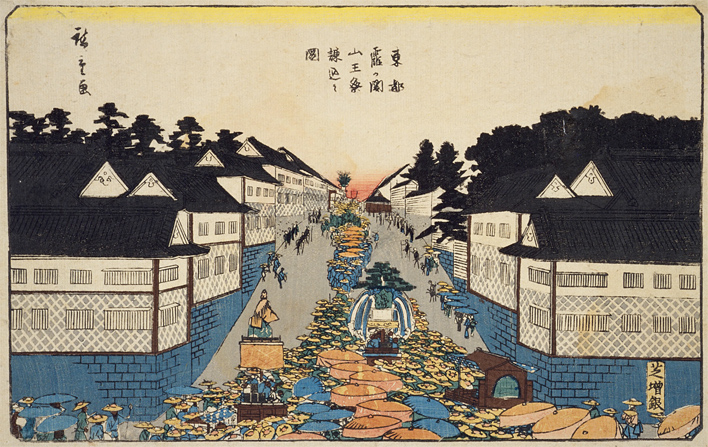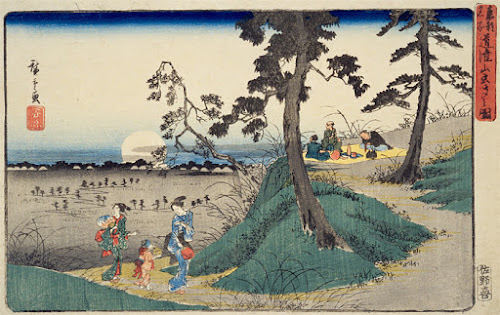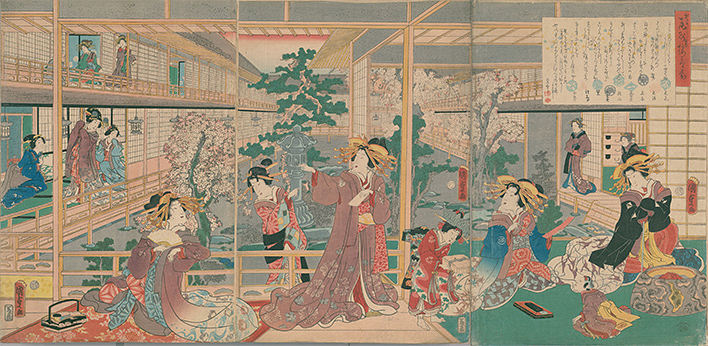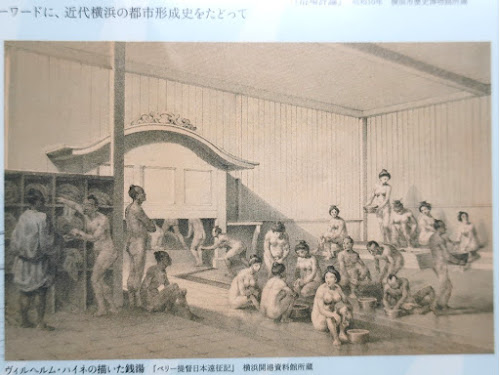Very good : ★★★ (this is a long and interesting page)
Various entertainments at Edo or old Tokyo in the Edo period
are written in this book. I found a lot of fun here. I focus on the fun of common
people, so I put aside the fun of Daimyo loads, samurais and rich merchants in
this book.
In terms of people’s fun, Edo was the paradise
definitely. There were a lot of funs in day time and night time. Edo attracted
people especially from the country side. I started from my favorite chapter.
三田村鳶魚(えんぎょ)の著作を事典にしたもの。江戸の生活の様々な楽しみが書かれていて、発見が多い。ここでは庶民の楽しみにフォーカスし、大名、武士、大店の主の楽しみは拾わなかった。
人の楽しみの面からみると、まさに、江戸はパラダイス。昼も夜も出会いも、いろいろなものがあって、人を地方からも引き付ける。気に入った章別にピックアップしていく。
人の楽しみの面からみると、まさに、江戸はパラダイス。昼も夜も出会いも、いろいろなものがあって、人を地方からも引き付ける。気に入った章別にピックアップしていく。
 |
| Edo or old Tokyo was very busy city, 熈代勝覧@三越前 |
Chapter 7: Daily lives、風俗概要
(1) Seasonal recreation、遊楽Seasonal recreations are written at first. On the New Year’s Day, people went out to see the sunrise. Also winter is a good season to see Mt.Fuji.
In March we have a girls' festival. We decorate Hina dolls which are dolls of noble people including the emperor and empress. In Edo castle, people could see the Hina dolls which noblewomen owned. They were gorgeous. I think, it was a great fun for both noblewomen and people who could see the dolls.
 |
Hina dolls 三段飾り@中島敏人形
|
Hina dolls in the Edo castle (open to the public)
大奥雛拝見(部分)https://dl.ndl.go.jp/info:ndljp/pid/1301732?tocOpened=1
 |
| Wisteria blossoms(足利フラワーパークの藤、2011年) |
I think that Yoshimune who was the shogun in mid Edo period influenced the change. He ordered to plant plenty of sakura trees on the riverside and the low mountain, so people could see a lot of sakura trees. Masters of dancing and shamisen (Japanese guitar) went out to see the sakura trees with their students. They danced, played and entertained people.
 |
Viewing sakura in April, 2017(上野公園)
|
 |
| Parties under sakura |
Hanabi firework and boat riding were fabulous attractions.
Originally, the firework was the event which held by the boat owners and restaurants in order to gather customers. They deposited money in order to launch fireworks on those particular days. On the 28th of May, boating season started.
Fireworks were launched and the night markets started the operation. In the boats, there were dancing spaces. Moreover there were private rooms in small boats, so people could enjoy love affairs.
That’s why the shogunate prohibited the boating sometimes.
In Bunka period, it was late Edo period, there were about 500 boats with roofs, and there were 700 small boats for each person.
Even now, the boating is popular. Some wealthy people get on the boats with geisha girls and enjoy the party. It is also popular among foreign tourists.
 |
| Boat riding(川遊び、江戸東京博物館) |
 |
| Fire works, photo by M.Takemoto |
Boating restaurant for foreigners in Tokyo:
http://www.harumiya.co.jp/overseas_edition/
At that time, strolling singers with Japanese guitar, impersonators and Fox-ken which was the kind of “paper, stone and scissors” game were popular.
https://ja.wikipedia.org/wiki/%E7%8B%90%E6%8B%B3
Another big entertainment in summer was to climb Mt.Fuji.
There were
many people who went to Mt.Fuji in groups called Fuji-kou. Each Fuji-kou
had participants from 50 to 200. Sendatu or a mountain guide, Kou-moto or an
organizer and Sewayaku or a caretaker leaded the kou. They left Edo in the
evening after greeting their acquaintances. They wore same outfits and had the
long sticks. It was popular before 1900.
The Fuji-kou is not so popular now but
climbing Mt.Fuji is still very popular.
 |
| Mt.Fuji in summer(三保の松原から) |
 |
| Autumn leaves in Rikugienn which was a daimyo's garden、六義園の紅葉 |
The major entertainment in winter was snow viewing. But the day time is short in winter, so I guess there was less entertainment in winter.
 |
| Garden in Kyoto, Toujiin temple、京都の等持院 |
7章 風俗概要
遊楽(ことばがいいですね)
初日の出の見物から始まる。東京からは水平線から登る朝日は見えないが、高輪などがスポットだったらしい。初富士は、空気の澄んだ寒い季節が良い。
春になると、桜、桃、つつじ、初夏になると潮干狩り、ホトトギス、ぼたん、かきつばた、藤、花菖蒲、と見るものが多く、
夏は、花火、蛍、蓮、朝顔、納涼となる。
秋は、月見、虫聞き、萩、菊細工、紅葉。ここまでは分かるが、吉原の灯篭というのも秋の遊楽に挙げられている。
冬は雪見。冬は日が短いので遠出をできず楽しみも限られていた模様。
雛祭りでは、江戸城内で上臈や女中が飾っていた雛を見ることができたという。これは、庶民にとっても、それを迎える女中たちにとっても、大きな喜びだったと思う。
花見は、天保(1830~1843)以前は一本桜や名木を楽しんでいたが、並木桜を大人数で楽しむように変わっていった。吉宗が隅田川土手や飛鳥山に多量の桜を植えたことが影響したのかもしれない。この頃には、踊りや三味線の師匠が弟子を従えて花見に出るし、茶番も行われていたとのこと。
花火と舟遊び。隅田川の花火は、もともと、涼み舟の客が花火を買って舟から打ち上げていたものだが、舟客を集めるために、舟宿や料理屋が金を集め日時を決めて、沢山の花火を打ち上げるようになったとのこと。
(注:花火大会実行委員会のWebには、8代将軍吉宗が、疫病で犠牲となった人々の慰霊を祈り、隅田川で水神祭を行い、両国橋周辺の料理屋が許可を得て花火を上げたのが始まり、と書かれている)
5月28日が川開きで、花火を打ち上げ、夜店も営業を始めた。舟に乗る芸者を見に来る人が多かったという。
舟の中に、襖絵や踊り場があったり、舟を2隻つなげたものも出て、度々禁制にあった。人目を避けられる舟の中はセックスを楽しむ場でもあったという。
文化の頃(1804‐1817)、屋形船が五六百艘、一人乗りの猪牙舟が七百艘あった。この頃の江戸には、新内流し、声色屋(ものまね)、狐拳も流行ったとのこと。
狐拳の絵(Wikipedia): https://ja.wikipedia.org/wiki/%E7%8B%90%E6%8B%B3
さて、様々な遊びを楽しんだ数寄者の隠居地は、葛西、本所、深川、目黒あたりだったらしい。そこでは、何が楽しかったのだろう、或いは、趣があったのだろうか。
続いて、富士登山。
六月になると江戸は富士講中の登山出立で賑やかになった。六月一日が富士の山開きで登山が許される。一つの講で50人から200人が富士向かう。先達(行者)、講元(主催者)、世話人がいて、みんなが町内をあいさつに回り、集合場所に集まって、夕刻に出発する。服を揃え、金剛杖を持った。
明治中期まで盛んであったとのこと。今は、参拝はさておき、登山として富士は外国人にも人気だ。
(2) Festivals and superstitions、祭りと迷信
There
have been two big festivals dedicated to the gods in Tokyo.
In Kanda festival,
people displayed lanterns and sake (Japanese rice wine) barrels in front of
their houses. Many people came to Kanda. Samurais hosted guests. This must be a
big fun.
In San-no festival, there was a long parade which included floats with female dancers and cosplayers. Some dancers became popular, and they were depicted on Ukiyoe printings. Those were sold as souvenirs, so the printing spread to countryside. Some girls succeeded to work at Daimyo (feudal lord) residences. By the way, the unique form of entertainment was visiting shrines and temples before 1700 (early Edo period).
In San-no festival, there was a long parade which included floats with female dancers and cosplayers. Some dancers became popular, and they were depicted on Ukiyoe printings. Those were sold as souvenirs, so the printing spread to countryside. Some girls succeeded to work at Daimyo (feudal lord) residences. By the way, the unique form of entertainment was visiting shrines and temples before 1700 (early Edo period).
 |
San-no festival by Hiroshige、東都名所・広重
国会図書館 https://www.ndl.go.jp/landmarks/details/detail005.html?keywords=sanno-festival
|
San-no festival: http://www.tenkamatsuri.jp/about/index.html
祭りと迷信
神田祭と山王祭となるが、神田祭では、町々で提灯を掲げ、酒樽を積み上げる。街は大いににぎわって、近隣からも見物人が来る。武家屋敷も賓客を迎えて饗応する。これは楽しい。
山王祭では、踊りをしている山車(踊り屋台)や仮装も含む大行列が練り歩く。踊り屋台で人気なった娘は、浮世絵になり、江戸土産となって全国に広まる。大奥に上がった者もいるという。
寺社参りは、元禄の頃までは唯一の娯楽であったという。この頃から、節分の豆まきやお札まきが盛り上がっていたらしい。
Daily entertainment、四季の風物
-En-nichi and night market
En-nichi is a special day dedicated to the deities or Buddha. Fair stalls are opened during the en-nichi. The stalls which sold green plants were always opened on this day. People bought the plants, set them and grew them in the alley where they lived. They enjoyed gardening. Furthermore, they could sell their plants by higher price than the price when they bought them. It was an investment too. I am sure it was a fun thing to do for people at that time.
En-nichi is a special day dedicated to the deities or Buddha. Fair stalls are opened during the en-nichi. The stalls which sold green plants were always opened on this day. People bought the plants, set them and grew them in the alley where they lived. They enjoyed gardening. Furthermore, they could sell their plants by higher price than the price when they bought them. It was an investment too. I am sure it was a fun thing to do for people at that time.
 |
| En-nich at Ueno(上野辨天堂、2018年) |
 |
| Plants on the alley(Shitamachi Museum 下町風俗資料館) |
Through my research, I’ve found out that the
night time en-nichi started to became very popular around 1800. Guys and girls
enjoyed encounters. In addition, the en-nichi made it easy for women and children to go out
at night. Various en-nichis were held almost every day in the 1900s.
People in the intellectual class went to mountains to hear the sounds of various insects. Mt.Asuka was famous for the sound of bell crickets, and Mt.Dokan was famous for that of pine crickets. It was cool that they set carpets on the ground and enjoyed finger foods and sake. I guess that they were accompanied by geisya-girls or other ladies.
People enjoyed fishing too. There were
several fishing places near the Tokyo bay. The good season was between spring
and autumn. Women had also got on fishing boats since Tenmei era (1781-1789).
It meant women were not satisfied with fishing from the shores. They caught
fishes such as crucian carps, eels, catfishes, and blowfishes.
By my research, the en-nichi in the night became very popular since around 1800. Guys and girls enjoyed encounters. The en-nichi made it easy for women and children to go out at night. The various kind of en-nichi was held almost every day about 1900.
- Outdoor life in the summer evening
People heard the voice of peddlers, such as that
of sellers of green soybean, sushi and soba noodle. These peddlers depended on
their distinctive calling voices to sell their merchandise. People in the intellectual class went to mountains to hear the sounds of various insects. Mt.Asuka was famous for the sound of bell crickets, and Mt.Dokan was famous for that of pine crickets. It was cool that they set carpets on the ground and enjoyed finger foods and sake. I guess that they were accompanied by geisya-girls or other ladies.
 |
| Hearing the sounds of insects、道潅山虫聞之図(広重) http://www.ndl.go.jp/landmarks/details/detail451.html?sights=dokanyama;tokyo=arakawa
|
They went to Kanagawa for fishing which is
25km away from the central Edo. They had one-day trip to Kanagawa in spring,
but they had two-day trip in winter. I guess people stayed there in order to
enjoy sashimi (row fish) and hot-pot parties because fishes are delicious in
winter. They caught fishes such as mackerels, horse mackerels, flounder
flatfishes, squids and freshwater prawns.
There were fishing ponds where people paid
money and fished such as carps.By my research, the en-nichi in the night became very popular since around 1800. Guys and girls enjoyed encounters. The en-nichi made it easy for women and children to go out at night. The various kind of en-nichi was held almost every day about 1900.
 |
| Portable fishing rod for small fishes and the case. We assemble the parts and make the fishing rod. フナの釣竿 Gallery of Edo Shitamachi Traditional Crafts 江戸下町伝統工芸館@浅草 |
四季の風物(英語にしにくいですねえ、日本らしい美しい言葉です)
縁日と夜店
縁日には植木屋が必ず出ていた。植木を置く場所は、裏店の路地のはずだが、植木は楽しみであり、良いものは高く売れるので投資でもあったと言う。これは、間違いなく庶民の楽しみだ。
調べたところ、縁日は夜の賑わいになり、「取持ち観音色薬師」と言われ始めたのが1800年頃。縁日で男女が出会うということですねえ。“色観音に取持ち地蔵、間男観音”など、別名が付くほど霊験があったとか。大正時代に一年で340日が縁日というピークになったそうだ。
子の日は大黒天、巳の日は弁財天、寅の日は毘沙門天、午の日はお稲荷さん、12日に一度の開催となる。庚申の日の帝釈天は60日に一度だが、この日は夜明かし。月の縁日は、閻魔様、薬師様、妙見様、観音様、お地蔵様、お不動様とあり、それぞれ市が立つと言うことだ。(http://nagoyakochan.cafe.coocan.jp/gogen/ennichi.html)
子の日は大黒天、巳の日は弁財天、寅の日は毘沙門天、午の日はお稲荷さん、12日に一度の開催となる。庚申の日の帝釈天は60日に一度だが、この日は夜明かし。月の縁日は、閻魔様、薬師様、妙見様、観音様、お地蔵様、お不動様とあり、それぞれ市が立つと言うことだ。(http://nagoyakochan.cafe.coocan.jp/gogen/ennichi.html)
ということで、江戸の夜は明るく、婦女子の外出も縁日によって促進されたそうだ。
夏の夜には、枝豆などの物売り、稲荷寿司や蕎麦を売る人の声が聞こえるとのこと。
知識階級は虫の音を聞きに行く。「虫聞き」と言うそうで、飛鳥山では鈴虫が、日暮里の道灌山では松虫が有名だったらしい。
粋なのは、筵や毛氈を敷いて、重箱の肴で瓢箪酒を傾けるということ。芸者さんというか、女将さんも一緒だったのでしょうかねえ。
知識階級は虫の音を聞きに行く。「虫聞き」と言うそうで、飛鳥山では鈴虫が、日暮里の道灌山では松虫が有名だったらしい。
粋なのは、筵や毛氈を敷いて、重箱の肴で瓢箪酒を傾けるということ。芸者さんというか、女将さんも一緒だったのでしょうかねえ。
釣りも楽しんでます。本所、築地を始め釣り場が載っており、春から秋が釣りの季節だったそうだ。天明(1781-1789)の頃からは、すでに婦人も釣り船に乗っていたのこと。陸釣りじゃあ満足できなかったらしい。トイレの問題は昔も今も変わらないと思いますがねえ。釣った魚は、フナ、キス、ウナギ、ナマズ、フグなどとある。
神奈川にも釣りに出かけてます。春は日帰り、なぜか寒い冬は一晩泊まりとあり、寒いけど冬の魚は美味しいから、お泊りを楽しんでいたのかな、と感じます。釣れる魚として、セイゴ、サバ、アジ、カレイ、イカ、アナゴ、テナガエビ、などなど。こういうのを食べていたのですねえ。そして、釣り堀もあったそうで、百文ほどとって、鯉や鮒を釣らせていたそうです。
神奈川にも釣りに出かけてます。春は日帰り、なぜか寒い冬は一晩泊まりとあり、寒いけど冬の魚は美味しいから、お泊りを楽しんでいたのかな、と感じます。釣れる魚として、セイゴ、サバ、アジ、カレイ、イカ、アナゴ、テナガエビ、などなど。こういうのを食べていたのですねえ。そして、釣り堀もあったそうで、百文ほどとって、鯉や鮒を釣らせていたそうです。
Chapter 1: Travel、旅
Highways, post towns and check points were well improved by the Tokugawa shogunate, so
people could enjoy travel easier. However people could not travel freely, they
needed to submit their travel plans to the local governments and to get approval.
Anyway, guidebooks were already published, so traveling became popular among the
people. Women had traveled since the end of 17th century.
Reference: 庶民と旅の歴史 The history of travel of Japanese ordinary people (published in 1971)
The most famous tour in the Edo period was visiting the Ise shrine, which became popular at the end of 17th century. It became popular opinion that the men must go to the Ise shrine at least once in their lives. Ise-kous, which were worshipper’s groups of the Ise shrine, were organized nationwide. They saved money to go to the Ise shrine and they had group tours. In the case of the Ise-kou tour, they could get government approval very easily, because visiting Ise shrine was a very respectable religious activity. People who didn’t have enough money went to Ise by asking donations of money and rice. Wealthy merchants in Kyoto and Osaka supported the poor travelers by offering food and other helps. The purposes of the merchants were both their worship and the advertising of their shops. An interesting thing in this chapter was Shochu liquor for removing fatigue of the legs. They sprayed it on their legs. I doubt the effect, but I can say they drunk the liquor later and enjoyed it.
Reference: 庶民と旅の歴史 The history of travel of Japanese ordinary people (published in 1971)
The most famous tour in the Edo period was visiting the Ise shrine, which became popular at the end of 17th century. It became popular opinion that the men must go to the Ise shrine at least once in their lives. Ise-kous, which were worshipper’s groups of the Ise shrine, were organized nationwide. They saved money to go to the Ise shrine and they had group tours. In the case of the Ise-kou tour, they could get government approval very easily, because visiting Ise shrine was a very respectable religious activity. People who didn’t have enough money went to Ise by asking donations of money and rice. Wealthy merchants in Kyoto and Osaka supported the poor travelers by offering food and other helps. The purposes of the merchants were both their worship and the advertising of their shops. An interesting thing in this chapter was Shochu liquor for removing fatigue of the legs. They sprayed it on their legs. I doubt the effect, but I can say they drunk the liquor later and enjoyed it.
 |
| Ise shrine on the New Year’s Day(初詣、2002年) |
1章 旅と飛脚
江戸時代には、街道、宿場、関所が整備される。東海道を登る権八という者が、川崎を越えて、いい宿があるという品川を目指して歩いている。宿選びをしっかり楽しんでいる。ガイドブックも発達していたし。貞享(1684-)のころからは、女性の旅が流行ったそうだ。
そして、江戸時代の旅といえば、熱狂の伊勢参り。元禄(1688-)のころから始まり、少なくとも男子は一生に一度は行くべしという観念が生じたらしい。
都市部でも農村でも伊勢講を作り、蓄えたお金で団体旅行した。
伊勢講と言えば、簡単に手形を貰えたそうだ。
資金がない人は、行く先々で米銭を乞いながら伊勢に向かったそうだ。後に、京大阪の豪商が、信仰と宣伝を兼ねて食料などを所々において支援したという。
幕末にはおかげ参りの熱狂的なフィーバーになるが、名古屋市博物館にはどこでフィーバーが始まったかの展示がされていた(2017年)。丹念に古文書を調べたのでしょう、素晴らしいことです。
都市部でも農村でも伊勢講を作り、蓄えたお金で団体旅行した。
伊勢講と言えば、簡単に手形を貰えたそうだ。
資金がない人は、行く先々で米銭を乞いながら伊勢に向かったそうだ。後に、京大阪の豪商が、信仰と宣伝を兼ねて食料などを所々において支援したという。
幕末にはおかげ参りの熱狂的なフィーバーになるが、名古屋市博物館にはどこでフィーバーが始まったかの展示がされていた(2017年)。丹念に古文書を調べたのでしょう、素晴らしいことです。
旅で面白いのが、疲れ直しの焼酎。足に吹きかけて疲れを取るというが、当然飲んでいたのだろう。
Chapter 6: Ladies、女人総記
There were a lot of mistresses in Edo, because the
ratio of men was higher.
Men paid for their mistresses around $1500 (current value) per month. There were also part time mistresses and men paid $500 for them. I think the part time job was so hard!
It was written in the old book that samurais, city guys and country guys who came to Edo frequently, had their own mistresses. I doubt the retired man, who was described in Yoshino’s diary, was one of them or not. There was the word “Kyo-kakoi”. “Kyo” means Kyoto city and “kakoi” means a mistress and her house. The man went to the house when he was in Kyoto.
Men paid for their mistresses around $1500 (current value) per month. There were also part time mistresses and men paid $500 for them. I think the part time job was so hard!
It was written in the old book that samurais, city guys and country guys who came to Edo frequently, had their own mistresses. I doubt the retired man, who was described in Yoshino’s diary, was one of them or not. There was the word “Kyo-kakoi”. “Kyo” means Kyoto city and “kakoi” means a mistress and her house. The man went to the house when he was in Kyoto.
Ladies started to work in shops after the mid-19th
century. It was not thought a good thing before then. In the early 19th
century, ladies could go out in the evening. They enjoyed en-nichi fairs
or the cool evening breeze.
In terms of the marriage, people didn’t meet before they got married
in Edo, but it was different in Kyoto and Osaka.
Some people in Kyoto and Osaka fell in love before they got married. I must explain that parents or matchmakers selected partners at that time.
Some people in Kyoto and Osaka fell in love before they got married. I must explain that parents or matchmakers selected partners at that time.
In Edo, it became common that parents sent their female children to
the Japanese dance schools where children learned not only dancing but also
decent manners. Girls who could perform the Japanese dance could work for
Daimyo lord which meant that girls earned a lot.
6章 女人総記
江戸女の分類の中に、囲い者というのがあり、男が多い大都市・江戸では妾が流行した。安政(1854-)の頃は、囲い者は月々3~6両、三四人の男に囲われる安囲いは1~2両という。安囲いは相手も数寄者だから大変だったろう。「天保の改革以来、武家町人、または諸国より年中出府している地方人がそれぞれ囲い者をするので・・・」と記載されている。吉野家日記の流山の隠居も、その手だろうか。また、京の月囲い、という言葉があって、京都滞在時に家を借りて囲うことを言った。面白い。
女性が店に出るようになったのは文久(1861-64)の頃からで、それまではあまり良い事とされなかった。一方、女の夜歩きは享和(1801-04)からで、涼みがてら縁日の夜見世に出かけた。
江戸では、見合いもせずに結婚していたが、上方では見合いが盛んで恋愛結婚もあった。また、踊りを習わせることが流行った。なぜなら、踊りができると大名屋敷に上がったりして金になったそうだ。
Chapter 8: Red-light district with prostitutes、花街と岡場所
The most famous red-light district was Yoshihara which was
authorized by the government.
Even ordinary craftsmen could go there after Ansei big earthquake in the mid-19th century. They became rich because they had a lot of good jobs to rebuild the houses.
Even ordinary craftsmen could go there after Ansei big earthquake in the mid-19th century. They became rich because they had a lot of good jobs to rebuild the houses.
Reference: The Great Yoshiwara (published in 2018)
There were illegal red-light districts too.
Those were restaurants and tea houses. The number of such kind of districts was around 40. Moreover there were about 4,000 prostitutes who stood on the streets or stayed at houses in Edo in the mid-18th century.
The girls who stood on the street were called "Yo-taka".
"Yo" means the night and "taka" means a hawk. The bool named "Yo-taka saiken" was published in 1845. Forty nine Yo-taka girls were introduced in that book, but it was said that the selling of the book was prohibited right after it was pulished. I guess that the contents of the book were extreme or people sought for the popular Yotakas and caused confusion.
In the post towns, there were inns and prostitutes. They were women called “Meshimori-onna” and “Sentaku-onna”. “Meshimori-onna" means a waitress. “Sentaku” means a laundry or washing and “onna” means a woman. Such kinds of women worked as prostitutes too. Shinagawa post town had 500 prostitutes, Shinjyuku, Senjyu and Itabashi post town had 150 prostitutes respectively.
Those were restaurants and tea houses. The number of such kind of districts was around 40. Moreover there were about 4,000 prostitutes who stood on the streets or stayed at houses in Edo in the mid-18th century.
The girls who stood on the street were called "Yo-taka".
"Yo" means the night and "taka" means a hawk. The bool named "Yo-taka saiken" was published in 1845. Forty nine Yo-taka girls were introduced in that book, but it was said that the selling of the book was prohibited right after it was pulished. I guess that the contents of the book were extreme or people sought for the popular Yotakas and caused confusion.
In the post towns, there were inns and prostitutes. They were women called “Meshimori-onna” and “Sentaku-onna”. “Meshimori-onna" means a waitress. “Sentaku” means a laundry or washing and “onna” means a woman. Such kinds of women worked as prostitutes too. Shinagawa post town had 500 prostitutes, Shinjyuku, Senjyu and Itabashi post town had 150 prostitutes respectively.
“Yu-na” is described next in this book.
“Yu” is hot water and “na” is a woman, so “yu-na” was a woman at a public bathhouse. The first public bathhouse opened in 1591 in Edo. Dozens of yu-nas scrubbed the person’s body, washed the hair, served a cup of hot water or tea, and talked with bathers. It was called “yu-na” bath, but the government restricted them severely later. I guess they had another business. Other type of bath houses started at Kanda, where people could listen to songs.
“Yu” is hot water and “na” is a woman, so “yu-na” was a woman at a public bathhouse. The first public bathhouse opened in 1591 in Edo. Dozens of yu-nas scrubbed the person’s body, washed the hair, served a cup of hot water or tea, and talked with bathers. It was called “yu-na” bath, but the government restricted them severely later. I guess they had another business. Other type of bath houses started at Kanda, where people could listen to songs.
Strangely enough, there were prostitutes called priestess. They were
originally peddlers who sold picture of the hell, but after around 1660, they
became prostitutes with shaved head as priestess. They were popular among some men.
Geisya-girls or Japanese dancers, waitresses
in tea houses and assistants in archery ranges worked at Edo. Edo might have
been a good place for guys.
Must check!: Kiyu-Shouran (Entertainment Encycl.) (Part 2) about prostitute
Must check!: Kiyu-Shouran (Entertainment Encycl.) (Part 2) about prostitute
8章 花街と岡場所
江戸で花街と言えば、吉原である。いわゆる公娼だ。安政以降(1854~)は職人も通ったらしい。大地震の普請で潤ったそうだ。
公娼が居るところは遊郭だが、私娼の居るところは岡場所となる。料理茶屋や煮売り茶屋、水茶屋などにしていたと言う。
深川、谷中、市谷の市中の他に、品川、千住、板橋、内藤新宿の江戸から一つ目の宿場町にもあり、40を数えた、とある。私娼も色々とあり、立ち夜鷹と街中には出ない座り夜鷹。宝暦(1751―)には4千人いたとも言う。49人の夜鷹を描いた夜鷹細見と言う本が1845年に出されたが、すぐに差し止めとなったそうだ。
深川、谷中、市谷の市中の他に、品川、千住、板橋、内藤新宿の江戸から一つ目の宿場町にもあり、40を数えた、とある。私娼も色々とあり、立ち夜鷹と街中には出ない座り夜鷹。宝暦(1751―)には4千人いたとも言う。49人の夜鷹を描いた夜鷹細見と言う本が1845年に出されたが、すぐに差し止めとなったそうだ。
宿場には、飯盛り女や洗濯女と言われた宿場公認の遊女が居た。品川には500人、千住、板橋、内藤新宿にも150人が居たらしい。
そして、湯女(ゆな)。
江戸では、天正19年(1591年)に銭瓶橋(東京駅付近)に初めて銭湯ができたそうだ。湯女数十人が、垢をかき、髪をすすぎ、湯や茶を持ってきて浮世語りをするとある。湯女風呂と呼ばれたが、後に幕府が厳しく規制したという。神田発祥の丹前風呂と言うのもあり、風呂屋で唄を聞いたらしい。
江戸では、天正19年(1591年)に銭瓶橋(東京駅付近)に初めて銭湯ができたそうだ。湯女数十人が、垢をかき、髪をすすぎ、湯や茶を持ってきて浮世語りをするとある。湯女風呂と呼ばれたが、後に幕府が厳しく規制したという。神田発祥の丹前風呂と言うのもあり、風呂屋で唄を聞いたらしい。
変わったところでは、比丘尼と言うのが居た。
元々は地獄絵図を持って悲しい声で物売りをしていたというが、1660年頃から坊主頭の遊女となったらしい。「比丘尼好き」と言う言葉があるぐらい、持てはやされたと言うが、「物好き」と言う意味ではなかろうか。
元々は地獄絵図を持って悲しい声で物売りをしていたというが、1660年頃から坊主頭の遊女となったらしい。「比丘尼好き」と言う言葉があるぐらい、持てはやされたと言うが、「物好き」と言う意味ではなかろうか。
接客婦としては、踊り子=芸者、水茶屋の娘、矢場(楊弓店)の娘もいる。江戸は楽しいところだ。
必見ページ: 嬉遊笑覧 (Part 2)・・・遊女の巻
参考ページ:吉原はスゴイ (堀口茉純、2018)
必見ページ: 嬉遊笑覧 (Part 2)・・・遊女の巻
参考ページ:吉原はスゴイ (堀口茉純、2018)
Chapter 4: Lives of ordinary people、僧と庶民
Shops opened at 6am in Edo. Peddlers started their jobs at 7am.
Craftsmen and employees worked from 7am to 5pm, so they worked 10 hours a day.
The employees who stayed at employer houses worked from 8am to 7 pm, so they
worked 11 hours a day.
It
was very important for people to take a bath. Public bathhouses became popular
mid Edo era. The number of bathhouses became 550 at the end of Edo period. In
my research, the number reached to 2500 in 1965, but the number declined to 600
in 2015 because most of houses equip a bath nowadays. Anyway, at that time, a
lot of people took bath two times a day, in the morning and in the evening.
Men and women got into same bath, but mixed bathing was prohibited
sometimes. Surprising fact was that men could see the female bath and women could
see the male bath until 150 years ago. Moreover there was almost no boundary in
male and female dressing rooms. About 20 people could soak in the bath at once.
It is Japanese way to take bath together. Some public bathhouses had clothes
rental shops on the second floor. People disguised and went to the red-light
districts. For example, a head clerk wore clothes for a craftsman. It is funny.
Specialties
of Edo were so many such as Nori sea weed of Asakusa, new soba noodle in
September, fresh-brewed sake rice wine, sweet dried persimmons. There were so
many specialties in Edo, so it must be fabulous for people to go to Edo.
4章 僧と庶民
江戸時代は、6時に店が開き、行商人は7時に家を出る。労働時間は、職人や雇われ人で7時から5時までの10時間、住込みは、8時から7時までの11時間だったそうだ。
商売としては、まず、風呂屋。江戸中期からでき始め、慶応には550軒があった。(ちなみに、1965年には2500軒、2015年は区部で600軒になっている)。一日に二回入浴する人が多く、朝夕が混んだ。混浴であったが、禁止されたこともあった。
明治の頃までは、男湯から女湯が見えたし、脱衣場は無境界のようなものだったという。浴槽には20人ほど入れる。一緒に入るのが日本の習慣だ。湯屋の二階には貸衣装屋があり、番頭が職人になったりして女郎屋に出かけていくという。これは面白い。
明治の頃までは、男湯から女湯が見えたし、脱衣場は無境界のようなものだったという。浴槽には20人ほど入れる。一緒に入るのが日本の習慣だ。湯屋の二階には貸衣装屋があり、番頭が職人になったりして女郎屋に出かけていくという。これは面白い。
面白い商売としては、美少女が給仕するという麦湯、房総砂が入った歯磨き粉を売る歯磨き屋。お歯黒の習慣があったはずなのに、白い歯を好んだのか。
江戸の名物として、浅草の海苔、9月の新蕎麦、新酒、甘干し柿、さんま、などなど多数記載されている。江戸に行くのは、大きな楽しみであったことは間違いない。
Chapter 9: Various Performances、各種の興行
People enjoyed Kabuki, Kyogen, sumo wrestling, Yose (storytelling, songs of girls). There were temporary theaters of acrobatics, magic, blowpipe, monsters mansion in Hiyokechi which was the area where all buildings were demolished in order to prevent the fire spreading.
Kabuki (YouTube) https://www.youtube.com/watch?v=JRznKiTXp6k
Kyogen (YouTube) https://www.youtube.com/watch?v=bTWcIXtk0qk
歌舞伎、狂言、相撲、寄席(講釈、講談、娘義太夫)、火除け地にあった見世物(軽業、手品、吹き矢、化け物屋敷)があった。
歌舞伎、狂言、相撲、寄席(講釈、講談、娘義太夫)、火除け地にあった見世物(軽業、手品、吹き矢、化け物屋敷)があった。
Yoshino’s daily life 07, September and October in 1849(嘉永2年秋)
Previous pset : Glossary, Regular Festival with Market En-nichi 縁日
江戸生活事典(稲垣史生、1959)
人の楽しみの発見度:★★★(長いページとなりましたが、おもしろいと思います)


Comments
Post a Comment